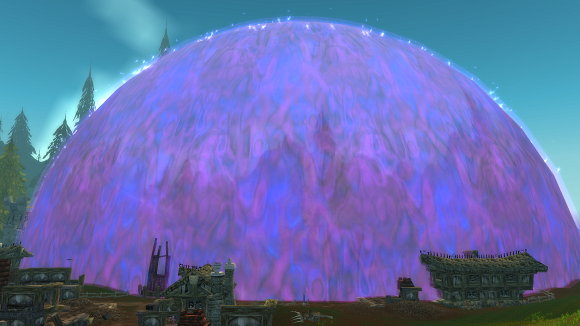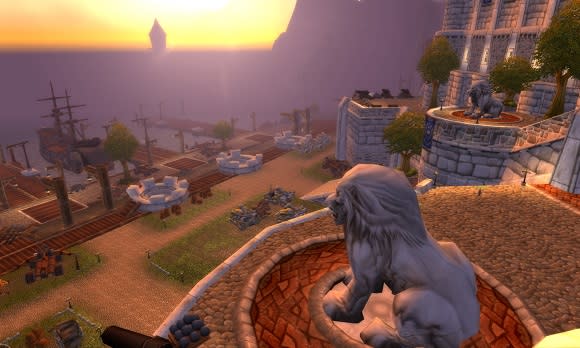WoW Archivist: Patch 3.0 -- Echoes of Doom

WoW Archivist explores the secrets of World of Warcraft's past. What did the game look like years ago? Who is etched into WoW's history? What secrets does the game still hold?
Patch 6.0 is finally upon us. Like all pre-expansion patches, it has been both invigorating and chaotic. Almost exactly six years ago, a similar patch went live to begin a new era in WoW. Blizzard called Wrath of the Lich King's pre-expansion patch "Echoes of Doom." On October 14, 2008, this third version of the game gave us the brand-new achievement system, inscription and glyphs, 51-point talent trees, the zombie plague event, and TO THE GROUND, BABY. Read on to see what WoW was like for those turbulent few weeks before Wrath of the Lich King's launch.
Dalaran, where art thou?
Through all of classic and The Burning Crusade, Dalaran sat in northern Hillsbrad, but players couldn't see it. An opaque purple dome walled off the Kirin Tor from the world at large. At the time, the enormous structure was one of the most striking landmarks in Azeroth. Although a few quests hinted at what lay beneath it, players new to the WoW universe had no idea what was there.
And then it was gone.
All that remained was a city-sized crater. I remember making a pilgrimage to this site during the 3.0 prepatch just to see it for myself. We couldn't go to Northrend yet to see the city first-hand. We had to wait for the launch of Wrath to do that. But looking at that crater certainly fired the imagination. I couldn't wait to find out what had been lurking under that dome for the first four years of the game.
I have to say, the city lived up to my high expectations.

WoW's Gamerscore
Achievements have become so synonymous with gaming that it's hard to imagine an era when messages didn't pop up to pat you on the back for everything tiny thing you accomplished. But it was once so. Specific video games had their own achievement-like systems for years. It wasn't until the Xbox 360's Gamerscore system, however, that achievements became a major part of gaming.
Achievements were a natural fit for WoW. With so many different things to do, the list of possible achievements, even at this point in the game, was practically endless.
Many players dove in headfirst, immediately addicted to that weeeeRUNG sound effect. Players often take the time before an expansion's debut to explore new aspects of the game or finish up things they hadn't had time for. Never was this more true than during the weeks after the 3.0 patch before Wrath's launch. We found ourselves doing things for 10 meaningless points that we'd never even considered prior to the achievement system. And we loved it.
Of course, not all achievements were just for points. What a Long, Strange Trip It's Been was a high profile meta-achievement whose coveted reward gave us a reason to participate in all the holidays. It showcased how the achievement system could add new dimensions to the game.
Drawing power

While some were grinding cheevs, others were milling herbs. Even though it was nominally a Wrath feature, inscription came with the patch. Only players who had purchased The Burning Crusade could learn and level it, however. In a time when Gamestop, Best Buy, et al. handled most preorders, Blizzard had no way to confirm whether or not you were actually going to buy Wrath, so requiring TBC on your account was the next best thing.
At first, glyphs were consumables. When you overwrote a glyph, it was gone forever. You had to carry around stacks of every glyph you'd ever have cause to apply. For frequently switched glyphs, players bought stacks of 20 at a time. Fortunately, glyphs required less ink than they do today. As you can see, the glyph UI looked very different back then.
They were a money maker for those who had the patience to level the profession and learn all the recipes -- even more so than today.
Glyphs had a mixed reception. To some players, they seemed too similar to talents (and some still feel that way). They also came with an inherent contradiction. On the one hand, you had to carry an array of glyphs around with you in case you needed them. On the other hand, most specs had mandatory glyphs that you never changed, so they became just another part of your "cookie cutter" build. Those who participated in both raiding and PvP had the worst of it, since these two aspects of the game often required completely different glyphs.
Cosmetic glyphs, however, were well received. A popular mage glyph, for example, was Glyph of the Penguin, which changed your Polymorph target into a penguin instead of a sheep.
It's kind of hard to believe that after six years, inscription is still the most recent major profession added to the game.

The tallest trees
In 3.0, players received the largest talent trees they'd ever have in WoW: each one culminated in a 51-point talent. As the pinnacle of the system, the 51-pointers not only had to be impactful, but also showcase what each spec was about. Here's a full and very interesting list:
Death Knight: Dancing Rune Weapon for Blood, Howling Blast for Frost, and Summon Gargoyle for Unholy
Druid: Starfall for Balance, Berserk for Feral, and Wild Growth for Restoration
Hunter: Beast Mastery for Beast Master, Chimera Shot for Marksmanship, and Explosive Shot for Survival
Mage: Arcane Barrage for Arcane, Living Bomb for Fire, and Deep Freeze for Frost
Paladin: Beacon of Light for Holy, Hammer of the Righteous for Protection, and Divine Storm for Retribution
Priest: Penance for Discipline, Guardian Spirit for Holy, and Dispersion for Shadow
Rogue: Hunger for Blood for Assassination, Killing Spree for Combat, and Shadow Dance for Subtlety
Shaman: Thunderstorm for Elemental, Feral Spirit for Enhancement, and Riptide for Restoration
Warlock: Haunt for Affliction, Metamorphosis for Demonology, and Chaos Bolt for Destruction
Warrior: Bladestorm for Arms, Titan's Grip for Fury, and Shockwave for Protection
Notice how so many of them are immediately recognizable today. It's a testament to Blizzard's class design team for Wrath that most of these talents still survive in the game, even after 6.0's pruning. They include some of the most beloved, spec-defining abilities ever designed.
When I look at the history of WoW, the specs within each class didn't truly come into their own until 3.0 went live. Before this patch, they were just sketches. Echoes of Doom gave them color and life.
Many talents caused huge excitement for their spec's players, especially Titan's Grip, Wild Growth, Beacon of Light, and Metamorphosis. The 51-point talent that received the most attention out of the gate, however, was Retribution's Divine Storm.

TO THE GROUND
In an expansion centered around the fallen paladin Arthas, it's no surprise that Blizzard wanted the only paladin DPS spec to fare better in raids than it had in classic and TBC. Back then, players called ret pallies "lolret" or "retardins," because the spec simply didn't have competitive DPS. Many raids carried at most one ret paladin (out of 40 or 25), mostly for their utility. If the encounter had a tight DPS requirement, ret paladins often found themselves benched.
As players in battlegrounds across the world found out on day one of the patch, Retribution wasn't just buffed. It had godlike burst, most of it unresistable holy damage. The 51-point talent Divine Storm was especially terrifying given its shiny animation and huge damage. Even WoW Insider's resident ret paladin at the time admitted that Blizzard had been way off the mark with ret's damage.
One day after 3.0 went live, Ghostcrawler made a fateful announcement. In a Q&A on the official forums, he answered the question, "Are we going to nerf ret?" His reply was, "TO THE GROUND, BABY." He was trying to lighten the mood, but the phrase became less of a joke and more like a prophecy.
The nerfs first went online on the still-running Wrath beta, and paladins did indeed feel nerfed to an altitude approaching sea level. Across-the-board damage reduction tends to give you that impression. Of all the nerfs, perhaps the most painful was that Divine Storm was changed to deal physical damage, in direct contradiction to the spell's name. Blizzard had previously said ret damage was OK on the Wrath beta during the previous BlizzCon, so some paladins felt betrayed and blindsided by the massive changes.
Ghostcrawler once again took to the forums to explain Blizzard's predicament to the ret community. It was pretty clear that Blizzard had goofed. The spec never should have gone live in its original state. But the damage had already been done. TO THE GROUND has become an enduring WoW meme and a rallying cry for paladins ever since.

Class changes
Naturally a patch of this magnitude brought many other class changes. Among the more notable ones:
Druids finally got an out-of-combat resurrection spell in Revive. Previously, they only had Rebirth, which was kind of awkward during dungeons when only one person was dead after a fight and no one else could rez. You had to decide whether to waste a lengthy cooldown picking them up or telling them to run back. If two people were dead, well, there was no good solution to that.
Activated paladin blessings such as Blessing of Sacrifice (as opposed to buffs like Blessing of Kings) became "hands" instead. Judgment no longer consumed seals. Yes, you had to rebuff your seal every time you judged through classic and TBC. And Lay on Hands no longer consumed the caster's entire mana bar -- previously, Lay on Hands was the ultimate spell of last resort.
Poisons were dispelled as a profession and became purchasable vendor items instead.
Demons no longer needed trainers to learn spells. They learned them automatically as they leveled. This quality of life change was a precursor to players learning spells the same way, which Blizzard didn't implement until Cataclysm.
A warrior talent called Armored to the Teeth tried to get warriors to wear plate instead of leather. Leather, for many reasons I've outlined elsewhere, was a DPS increase over plate for warriors during the first half of WoW's existence. Armored to the Teeth gave warriors attack power that scaled with their armor bonus. It still wasn't enough, and warriors continued to prefer leather when they could get it.
This happened: "Druids and Shaman can now use items while shapeshifted." Sure, a cat shouldn't be able to drink a potion and a ghost wolf shouldn't be able to throw a Saronite Bomb, but convenience must sometimes trump realism.
Hunter pets received their own talent trees based on their type -- cunning, ferocity, or tenacity. The trees only lasted for two expansions, however. They went away in Mists.

Other goodies
The list of updates from this patch is impressive. Patch 3.0 also gave us the barber shop, the in-game calendar, the focus frame, and the modern pet and mount UI. Pets and mounts weren't yet account wide, but the UI was a vast improvement over their previous incarnation as individual items that clogged up bags.
Caster-only secondary stats spell hit, spell crit, and spell haste fused with physical-only hit, crit, and haste to become the role-agnostic stats we have today. Spell damage and spell healing merged into spell power, to the relief of healers everywhere, who could now actually use their healing gear for solo questing.
Stormwind's Department of Transportation made some infrastructure improvements and built the city's harbor.
Sweeping nerfs to TBC dungeons and raids made the content more accessible to some players, but enraged others.
Finally, no review of this patch would be complete without mentioning the amazing zombie plague event -- certainly the most popular and controversial pre-expansion event that WoW players have ever experienced. But it was too awesome to cover it adequately here. It deserves its own Archivist column, so we will leave the details for another time.
Patch 3.0 was a landmark for WoW. It ushered in the era of the game's highest ever subscriber numbers and the expansion that a vast majority of WoW Insider readers cite as their favorite. Will 6.0 earn the same high regard after six years? Future me writing an Archivist column in 2020 has the answer, but he's too busy with patch 12.0 to tell us.
Click through for the full 3.0.2 patch notes!

After months of surveying, WoW Archivist has been dug back up! Discover lore and artifacts of WoW's past, including the Corrupted Blood plague, the Scepter of the Shifting Sands, and the mysterious Emerald Dream.
